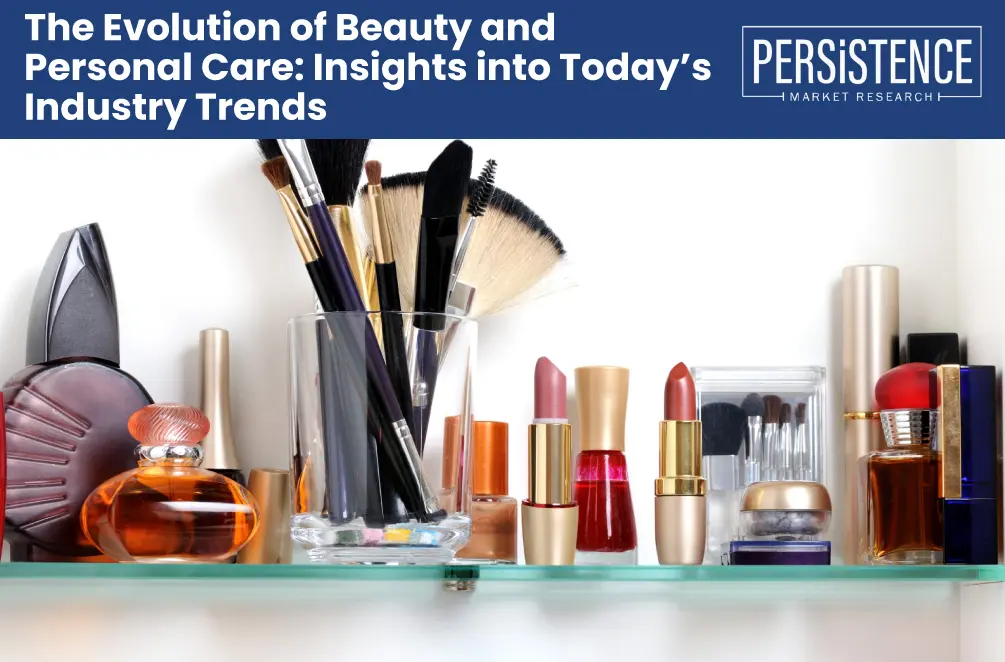- Blog
- Beauty Personal Care Trends
The Evolution of Beauty and Personal Care: Insights into Today’s Industry Trends
Published On : 21 Jul 2025
Beauty and personal care encompass a wide range of products and practices designed to enhance appearance, hygiene, and overall well-being. This includes skincare, makeup, haircare, fragrances, and grooming products. Skincare involves cleansers, toners, serums, and moisturizers that nourish and protect the skin, while makeup allows for creative expression and enhancement of natural features. Haircare products such as shampoos, conditioners, and masks cater to different hair types and concerns. The industry also embraces natural and organic options, reflecting consumers’ growing preference for clean and sustainable formulations.

What are the current consumer expectations in the beauty and personal care industry?
Today’s consumers are more informed and discerning, demanding transparency about ingredients and sustainability. A significant portion of consumers seek environmentally friendly brands, and more than half are willing to pay a premium for sustainable products. Ingredient transparency and functional benefits have become critical, with consumers favoring products that address specific skin or hair concerns and deliver tangible results over time.
How is sustainability shaping the beauty and personal care cosmetics industry?
Sustainability is a dominant trend, with a surge in demand for natural, organic, and “clean” beauty products. Consumers increasingly scrutinize product ingredients for their environmental and health impacts, driving brands to innovate with eco-friendly formulations and packaging. Retailers like Walmart have responded by launching dedicated clean beauty sections, making sustainable products more accessible and mainstream. Search interest in sustainable skincare has doubled over the past five years, underscoring the growing consumer commitment to eco-conscious choices.
What role does technology and AI play in the evolution of beauty and personal care?
Technology, especially artificial intelligence (AI), is revolutionizing the beauty industry by enabling hyper-personalization, efficiency, and innovation. AI-driven tools allow for personalized skincare regimens based on DNA testing, real-time skin health monitoring, and advanced data analytics. Virtual try-ons and AI-powered diagnostics enhance the consumer experience by providing tailored recommendations and reducing guesswork. This integration of AI supports a more inclusive and effective beauty experience, aligning with consumer demand for customized solutions that are tailored to their needs.
How are wellness and mental health influencing beauty trends?
The concept of beauty is expanding beyond external appearance to incorporate mental and emotional well-being. The emerging trend of “NeuroGlow” highlights the mind-body connection, where beauty products and routines are designed to improve both skin health and psychological wellness. Innovations such as psychodermatology and neurocosmetics explore how mental states affect skin conditions, while wearable devices provide feedback on stress and skin health. This holistic approach is reshaping product development and marketing, reflecting consumers’ desire for wellness-oriented beauty solutions that nurture both body and mind.
What are the emerging product trends and microtrends in the industry?
Microtrends, often short-lived but impactful, are shaping consumer preferences, especially among younger demographics like Gen Z. Examples include graphic eyeliners, lip stains, and tinted moisturizers, which gain rapid popularity through social media platforms such as Instagram and TikTok.
Skincare ingredients like salicylic acid and niacinamide are now incorporated into haircare, body care, and makeup, blurring traditional category lines. This trend reflects consumers’ demand for multifunctional products that promote long-term health and beauty benefits.
How is the rise of inclusivity and diversity impacting the beauty and personal care industry?
The beauty and personal care sector has transformed its product development, marketing, and branding based on inclusivity and diversity as new pillars of the industry. Modern consumers expect brands to represent a broad spectrum of skin tones, hair types, genders, and cultural backgrounds, moving away from the historically narrow definitions of beauty. This shift is evident in the expansion of foundation shades to accommodate all skin tones, gender-neutral product lines, and campaigns featuring diverse models and influencers.
How is the beauty and personal care market adapting to premium yet affordable products?
Despite economic pressures, consumers are adopting a more strategic approach to beauty spending. Although price sensitivity exists, a large number of consumers are trading down in one category to afford premium products in others in the search to get value without sacrificing quality. These dynamic fuels the growth of both affordable “dupes” and high-end offerings. Brands are responding by balancing premium formulations with accessible pricing and emphasizing ingredient-led, effective products. This nuanced consumer behavior is driving innovation and diversification across the market.
Conclusion
The beauty and personal care industry in 2025 is characterized by a strong commitment to sustainability, transparency, and personalization, fueled by technological advancements and a holistic view of wellness.
Industry Report

Request Report Sample
Your privacy is important to us; your data is secure
Contact Us
Latest Reports
-
Piezoresistive Pressure Sensor Market by Sensor Type (Absolute, Gauge, Differential, Sealed), Pressure Range (Low Pressure (<10 kPa), Medium Pressure (10 kPa – 1000 kPa), High Pressure (>1000 kPa)), End-Use Industry (Automotive & Transportation, Industrial Manufacturing, Healthcare, Aerospace & Defense, Electronics) and Regional Analysis for 2026-2033
-
Aquarium Accessories Market by Product Type (Filtration Items, Lights & Hoods, Temperature Control Systems, Others), End-User (Residential, Commercial), Distribution Channel (Online, Offline), and Regional Analysis for 2026-2033
-
Oxygen Therapy Market by Product Type (Compressed Oxygen, Concentrated Oxygen, Liquid Oxygen), Disease (Respiratory Disorder, Cardiovascular Disease, Sleep Apnea, Pneumonia), End-User (Hospitals, Home Healthcare, Clinics), and Regional Analysis for 2026-2033
-
Air Curtains Market by Product Type (Non‑Recirculating, Recirculating, Heated, Others), Airflow Capacity (Up to 500 m³/h, 500–1000 m³/h, 1000–1500 m³/h, Above 1500 m³/h), Application (Commercial, Industrial, Residential, Others), and Regional Analysis for 2026–2033
-
Personalized Stationery Market by Product type (Storage & Filling Products, Paper-Based Products, Drawing & Writing Instruments, Accessories, Bags, Others), Application (Educational Institutes, Corporate Offices, Personal Use, Hospitals, Others), and Regional Analysis for 2026–2033
